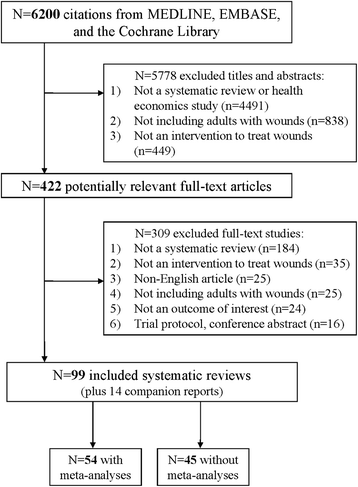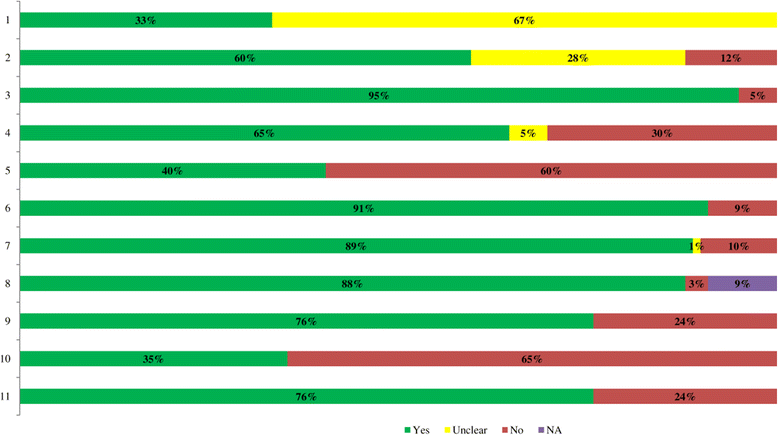Seeking effective interventions to treat complex wounds: an overview of systematic reviews
- PMID: 25899006
- PMCID: PMC4406332
- DOI: 10.1186/s12916-015-0288-5
Seeking effective interventions to treat complex wounds: an overview of systematic reviews
Abstract
Background: Numerous, often multi-faceted regimens are available for treating complex wounds, yet the evidence of these interventions is recondite across the literature. We aimed to identify effective interventions to treat complex wounds through an overview of systematic reviews.
Methods: MEDLINE (OVID interface, 1946 until October 26, 2012), EMBASE (OVID interface, 1947 until October 26, 2012), and the Cochrane Database of Systematic Reviews (Issue 10 of 12, 2012) were searched on October 26, 2012. Systematic reviews that examined adults receiving care for their complex wounds were included. Two reviewers independently screened the literature, abstracted data, and assessed study quality using the Assessment of Multiple Systematic Reviews (AMSTAR) tool.
Results: Overall, 99 systematic reviews were included after screening 6,200 titles and abstracts and 422 full-texts; 54 were systematic reviews with a meta-analysis (including data on over 54,000 patients) and 45 were systematic reviews without a meta-analysis. Overall, 44% of included reviews were rated as being of high quality (AMSTAR score ≥ 8). Based on data from systematic reviews including a meta-analysis with an AMSTAR score ≥ 8, promising interventions for complex wounds were identified. These included bandages or stockings (multi-layer, high compression) and wound cleansing for venous leg ulcers; four-layer bandages for mixed arterial/venous leg ulcers; biologics, ultrasound, and hydrogel dressings for diabetic leg/foot ulcers; hydrocolloid dressings, electrotherapy, air-fluidized beds, and alternate foam mattresses for pressure ulcers; and silver dressings and ultrasound for unspecified mixed complex wounds. For surgical wound infections, topical negative pressure and vacuum-assisted closure were promising interventions, but this was based on evidence from moderate to low quality systematic reviews.
Conclusions: Numerous interventions can be utilized for patients with varying types of complex wounds, yet few treatments were consistently effective across all outcomes throughout the literature. Clinicians and patients can use our results to tailor effective treatment according to type of complex wound. Network meta-analysis will be of benefit to decision-makers, as it will permit multiple treatment comparisons and ranking of the effectiveness of all interventions. Please see related article: http://dx.doi.org/10.1186/s12916-015-0326-3.
Figures


Similar articles
-
Systematic reviews of wound care management: (5) beds; (6) compression; (7) laser therapy, therapeutic ultrasound, electrotherapy and electromagnetic therapy.Health Technol Assess. 2001;5(9):1-221. doi: 10.3310/hta5090. Health Technol Assess. 2001. PMID: 11368833 Review.
-
Management of chronic pressure ulcers: an evidence-based analysis.Ont Health Technol Assess Ser. 2009;9(3):1-203. Epub 2009 Jul 1. Ont Health Technol Assess Ser. 2009. PMID: 23074533 Free PMC article.
-
Wound cleansing for treating venous leg ulcers.Cochrane Database Syst Rev. 2021 Mar 10;3(3):CD011675. doi: 10.1002/14651858.CD011675.pub2. Cochrane Database Syst Rev. 2021. PMID: 33734426 Free PMC article.
-
Systematic reviews of wound care management: (3) antimicrobial agents for chronic wounds; (4) diabetic foot ulceration.Health Technol Assess. 2000;4(21):1-237. Health Technol Assess. 2000. PMID: 11074391 Review.
-
[Local wound care: evidence-based treatments and dressings].Ned Tijdschr Geneeskd. 2006 May 27;150(21):1165-72. Ned Tijdschr Geneeskd. 2006. PMID: 16768278 Review. Dutch.
Cited by
-
The effectiveness of negative pressure wound therapy as a novel management of diabetic foot ulcers: an overview of systematic reviews.J Diabetes Metab Disord. 2019 Nov 25;18(2):625-641. doi: 10.1007/s40200-019-00447-6. eCollection 2019 Dec. J Diabetes Metab Disord. 2019. PMID: 31890688 Free PMC article. Review.
-
[National expert consensus on the application of negative pressure wound therapy in the treatment of diabetic foot wounds (2021 version)].Zhonghua Shao Shang Za Zhi. 2021 Jun 10;37(6):508-518. doi: 10.3760/cma.j.cn.501120-20210107-00010. Online ahead of print. Zhonghua Shao Shang Za Zhi. 2021. PMID: 34139827 Free PMC article. Chinese.
-
Wound Care Knowledge, Attitudes, and Practices and Mobile Health Technology Use in the Home Environment: Cross-Sectional Survey of Social Network Users.JMIR Mhealth Uhealth. 2020 Mar 26;8(3):e15678. doi: 10.2196/15678. JMIR Mhealth Uhealth. 2020. PMID: 32213478 Free PMC article.
-
Enhancing diabetic foot ulcer healing: Impact of the regulation of the FUS and ILF2 RNA‑binding proteins through negative pressure wound therapy.Int J Mol Med. 2024 Nov;54(5):103. doi: 10.3892/ijmm.2024.5427. Epub 2024 Sep 20. Int J Mol Med. 2024. PMID: 39301661 Free PMC article.
-
Advanced Wound Care Strategies in Patients with NSTIs.J Clin Med. 2025 May 17;14(10):3514. doi: 10.3390/jcm14103514. J Clin Med. 2025. PMID: 40429509 Free PMC article. Review.
References
-
- Adderley U, Smith R. Topical agents and dressings for fungating wounds. Cochrane Database Syst Rev. 2007;2 - PubMed
Publication types
MeSH terms
Grants and funding
LinkOut - more resources
Full Text Sources
Other Literature Sources
Medical

